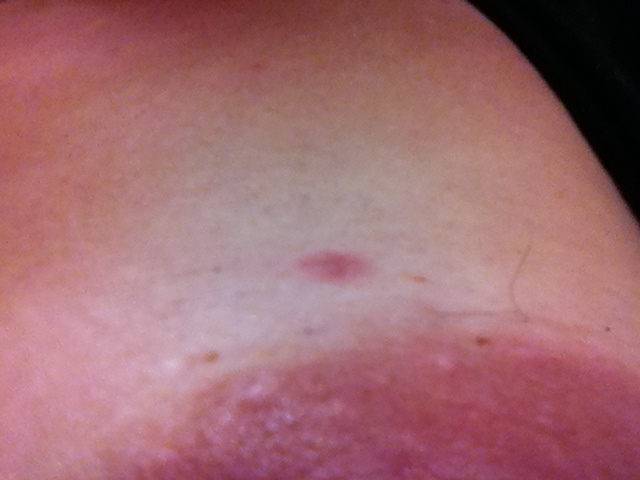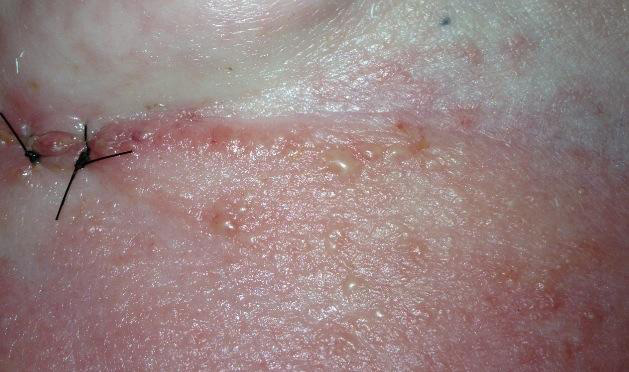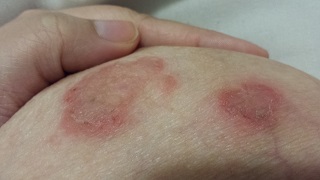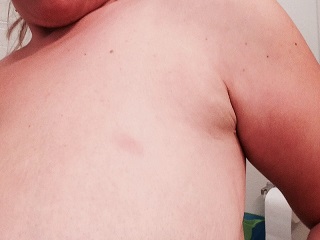Accounting for one to five percent of all breast cancer cases in the United States, inflammatory breast cancer, or IBC, is an aggressive, rare form of this disease. Inflammatory breast cancer pictures show a red and/or swollen breast that appears inflamed. Most cases are invasive ductal carcinomas, which develop in the cells lining the milk ducts and spread throughout the breast. Cells also blocks the lymph vessels located in the skin of the breast.
Inflammatory Breast Cancer Pictures and Symptoms
The symptoms of IBC include a breast that:
- Quickly changes appearance
- Looks larger, thicker or heavier
- Feels very warm
- Has skin that looks dimpled or ridged like an orange
- Is tender, aches or feels painful
- Has larger lymph nodes under the arm or around the collarbone
- Has a flatter nipple or one that is turned inward
- Turns inward (Usually, nipples that turn inward, or inverted nipples, are nothing to be concerned with, but it could be a symptom of IBC. If the inverted nipple doesn’t turn outward again, contact a healthcare provider for a breast exam. They may order a mammogram or biopsy to check for breast cancer.)
Unlike other forms of breast cancer, there is no lump formation with IBC.
Inflammatory Breast Cancer Pictures of Different Symptoms
Below are some of the pictures of IBC for reference only, you may not experience them at all. If you find anything abnormal with your breast and are concerned, do not hesitate to visit your doctor.

As these inflammatory breast cancer picture shows, the texture of the breast may change and appear to look dimpled or ridged, like an orange peel. This is referred to as peau d’orange, which is French for “orange skin” and it is caused by cancer cells blocking the lymph vessels beneath the skin, which have formed into ridges or tiny lumps.

One of the first symptoms women experience is the breast appearing to be red, pink or purple. The discoloration may look like bruising that covers one-third or more of the breast. It may also feel warm or be tender.

With IBC, the skin may appear to be splotchy or irritated and there may be bumps present.

Inflammatory breast cancer pictures show the discoloration that can appear.

This type of breast cancer is so aggressive that by the time patients notice symptoms, it may have already spread to the lymph nodes under the arm or around the collarbone, making them appear swollen.
Diagnosing Inflammatory Breast Cancer
If you are being treated for swelling or redness of the breast and it doesn’t seem to be getting better after taking antibiotics for a week, your healthcare provider may order imaging tests to check for IBC. These tests may include an ultrasound and the following:
- Mammogram – This test will be done to check the thickness of the skin and the density of the treated breast in comparison to the healthy breast.
- MRI – It takes images of the breast and structures of your body using radio waves and magnets.
- CT – This scan provides detailed images of your body’s insides.
- PET – This scan, along with a CT, can find cancer in any area of the body, including the lymph nodes.
- Biopsy – This test is done by removing a small piece of the skin or tissue of the breast to help diagnose cancer. A biopsy can sometimes be done with a needle or a surgical incision may be needed to remove tissue for testing. The type of biopsy performed with depends on whether a mass is discernible on imaging tests. The test will look for unusual cell growth and check for the presence of proteins found in some cancers.
Stages of Inflammatory Breast Cancer
- Stage IIIB indicates the cancer is present in the issues in the skin or chest wall, near the breast. It may also be found in the muscles of the chest or in the ribs. It may have also spread to breast lymph nodes or those present under the arm.
- In Stage IIIC, inflammatory breast cancer pictures may show cancer in the lymph nodes by the neck or under the collarbone. It may also be found in the lymph nodes of the breast, under the arm or in tissues close to the breast.
- A Stage IV diagnosis means the cancer is present in other areas of the body, including bones, organs like the liver, lungs, brain or in the lymph nodes of the neck.
How Is It Treated?
A multi-modal approach is usually taken to treat IBC, which means more than one treatment is used. This approach has been shown to produce better treatment responses and longer survival rates for patients. The treatments often included in a multi-modal approach are:
- Neoadjuvant chemotherapy – Usually six cycles of this chemotherapy are used over four to six months prior to surgery to remove a tumor. If the cancer continues to spread during these treatments, the surgery may commence.
- Targeted therapy – This usually done when biopsy tests reveal that a tumor can be treated with certain drugs. Since IBC can produce large amounts of the HER2 protein, it may be targeted with a drug like trastuzumab or Herceptin. Studies show that IBC treated with this drug along with chemotherapy, responds better and improves survival rates.
- Hormone therapy – If hormone receptors are detected during a biopsy, then drugs are used to bind to the receptors and prevent further hormones from being produced, which will stop cancer cells from growing and kill them.
- Surgery – The standard procedure for IBC patients is often a modified radical mastectomy. This involves removing the entire breast, along with the lymph nodes under the arm on the same side. Sometimes the lining of the chest muscle or a small chest muscles may need to be removed as well.
- Radiation – This is done after a mastectomy, but prior to a breast reconstruction.
- Adjuvant therapy – Additional treatments like chemotherapy, targeted therapies, or antihormonal treatments or any combination of them may be done to help keep the cancer from coming back.
- Supporter or palliative care – This is done to improve the patient's quality of life in cases of life-threatening IBC and to give their caretakers and loved ones support.
